Mineral Composition and Antioxidant Potential of Coffee Beverages Depending on the Brewing Method
Abstract
1. Introduction
2. Materials and Methods
2.1. Coffee Brewing Methods
2.2. Spectrophotometric Assay
2.2.1. Determination of Antioxidant Activity
2.2.2. Determination of Total Polyphenol Content
2.2.3. Determination of the Reduction Potential by the FRAP (Ferric Reducing of Antioxidant Power) Method
2.3. Determination of Total Acidity by Titration
2.4. Determination of Mineral Content
2.5. Statistical Analysis
3. Results
3.1. Analysis of Antioxidant Properties of Coffee Preparations
3.2. Correlations between the Analysed Parameters for Individual Brewing Methods
- -
- Between percentage DPPH inhibition and polyphenol content in Aeropress (r = 0.828), drip (r = 0.949), espresso (r = 0.752), and French press (r = 0.731).
- -
- Between DPPH and FRAP for Aeropress (r = 0.919), drip (r = 0.990), and espresso (r = 0.932).
- -
- Between polyphenol content and FRAP for Aeropress (r = 0.972), drip (r = 0.982), and espresso (r = 0.972).
- -
- The only correlation found in simple infusion was between DPPH and FRAP (r = 0.914).
4. Discussion
Author Contributions
Funding
Acknowledgments
Conflicts of Interest
References
- Torquati, L.; Peeters, G.; Brown, W.J.; Skinner, T.L. A Daily Cup of Tea or Coffee May Keep You Moving: Association between Tea and Coffee Consumption and Physical Activity. Int. J. Environ. Res. Public Health 2018, 15, 1812. [Google Scholar] [CrossRef] [PubMed]
- Lire Wachamo, H. Review on Health Benefit and Risk of Coffee Consumption. Med. Aromat. Plants 2017, 6, 4. [Google Scholar] [CrossRef]
- Gaascht, F.; Dicato, M.; Diederich, M. Coffee provides a natural multitarget pharmacopeia against the hallmarks of cancer. Genes Nutr 2015, 10, 51. [Google Scholar] [CrossRef] [PubMed]
- Zain, M.Z.M.; Shori, A.B.; Baba, A.S. Composition and Health Properties of Coffee Bean. Eur. J. Clin. Biomed. Sci. 2017, 3, 97–100. [Google Scholar] [CrossRef]
- Sarriá, B.; Martínez-López, S.; Sierra-Cinos, J.L.; García-Diz, L.; Mateos, R.; Bravo-Clemente, L. Regularly consuming a green/roasted coffee blend reduces the risk of metabolic syndrome. Eur. J. Nutr. 2018, 57, 269–278. [Google Scholar] [CrossRef] [PubMed]
- Wolska, J.; Janda, K.; Jakubczyk, K.; Szymkowiak, M.; Chlubek, D.; Gutowska, I. Levels of Antioxidant Activity and Fluoride Content in Coffee Infusions of Arabica, Robusta and Green Coffee Beans in According to their Brewing Methods. Biol. Trace Elem. Res. 2017, 179, 327–333. [Google Scholar] [CrossRef]
- Caprioli, G.; Cortese, M.; Sagratini, G.; Vittori, S. The influence of different types of preparation (espresso and brew) on coffee aroma and main bioactive constituents. Int. J. Food Sci. Nutr. 2015, 66, 505–513. [Google Scholar] [CrossRef]
- Dybkowska, E.; Sadowska, A.; Rakowska, R.; Dębowska, M.; Świderski, F.; Świąder, K. Assessing polyphenols content and antioxidant activity in coffee beans according to origin and the degree of roasting. Rocz. Panstw. Zakl. Hig. 2017, 68, 347–353. [Google Scholar]
- Fuller, M.; Rao, N.Z. The Effect of Time, Roasting Temperature, and Grind Size on Caffeine and Chlorogenic Acid Concentrations in Cold Brew Coffee. Sci. Rep. 2017, 7, 1–9. [Google Scholar] [CrossRef]
- Grembecka, M.; Malinowska, E.; Szefer, P. Differentiation of market coffee and its infusions in view of their mineral composition. Sci. Total Environ. 2007, 383, 59–69. [Google Scholar] [CrossRef]
- Pérez-Burillo, S.; Mehta, T.; Esteban-Muñoz, A.; Pastoriza, S.; Paliy, O.; Ángel Rufián-Henares, J. Effect of in vitro digestion-fermentation on green and roasted coffee bioactivity: The role of the gut microbiota. Food Chem. 2019, 279, 252–259. [Google Scholar] [CrossRef] [PubMed]
- Anesini, C.; Ferraro, G.; Filip, R. Total Polyphenol Content and Antioxidant Capacity of Commercially Available Tea (Camellia sinensis) in Argentina. J. Agric. Food Chem. 2008, 56, 9225–9229. [Google Scholar] [CrossRef] [PubMed]
- Nielsen, S.S. Standard Solutions and Titratable Acidity. In Food Analysis Laboratory Manual; Nielsen, S.S., Ed.; Food Science Texts Series; Springer US: Boston, MA, USA, 2010; pp. 95–102. ISBN 978-1-4419-1463-7. [Google Scholar]
- Grosso, G.; Godos, J.; Galvano, F.; Giovannucci, E.L. Coffee, Caffeine, and Health Outcomes: An Umbrella Review. Annu. Rev. Nutr. 2017, 37, 131–156. [Google Scholar] [CrossRef] [PubMed]
- Gloess, A.N.; Schönbächler, B.; Klopprogge, B.; D’Ambrosio, L.; Chatelain, K.; Bongartz, A.; Strittmatter, A.; Rast, M.; Yeretzian, C. Comparison of nine common coffee extraction methods: Instrumental and sensory analysis. Eur. Food Res. Technol. 2013, 236, 607–627. [Google Scholar] [CrossRef]
- Moeenfard, M.; Erny, G.L.; Alves, A. Variability of some diterpene esters in coffee beverages as influenced by brewing procedures. J. Food Sci. Technol. 2016, 53, 3916–3927. [Google Scholar] [CrossRef]
- Pavesi Arisseto, A.; Vicente, E.; Soares Ueno, M.; Verdiani Tfouni, S.A.; De Figueiredo Toledo, M.C. Furan Levels in Coffee as Influenced by Species, Roast Degree, and Brewing Procedures. J. Agric. Food Chem. 2011, 59, 3118–3124. [Google Scholar] [CrossRef]
- Alves, R.C.; Almeida, I.M.C.; Casal, S.; Oliveira, M.B.P.P. Isoflavones in coffee: Influence of species, roast degree, and brewing method. J. Agric. Food Chem. 2010, 58, 3002–3007. [Google Scholar] [CrossRef]
- Angeloni, S.; Navarini, L.; Khamitova, G.; Sagratini, G.; Vittori, S.; Caprioli, G. Quantification of lignans in 30 ground coffee samples and evaluation of theirs extraction yield in espresso coffee by HPLC-MS/MS triple quadrupole. Int. J. Food Sci. Nutr. 2019, 1–8. [Google Scholar] [CrossRef]
- European Food Safety Authority (EFSA). Dietary Reference Values for nutrients. EFSA Supporting Publ. 2017, 14. [Google Scholar] [CrossRef]
- European Food Safety Authority (Ed.) Tolerable upper Intake Levels for Vitamins and Minerals; European Food Safety Authority: Parma, Italy, 2006; ISBN 978-92-9199-014-6. [Google Scholar]
- Chen, P.S.; Bornhorst, J.; Aschner, M. Manganese metabolism in humans. Front. Biosci. 2018, 23, 1655–1679. [Google Scholar] [CrossRef]
- EFSA Panel on Dietetic Products, Nutrition and Allergies (NDA). Scientific Opinion on Dietary Reference Values for chromium. EFSA J. 2014, 12, 3845. [Google Scholar] [CrossRef]
- World Health Organization. Guideline; WHO Press: Geneva, Switzerland, 2012; ISBN 978-92-4-150483-6. [Google Scholar]
- Jarosz, M.; Rychlik, E.; Stoś, K.; Wierzejska, R.; Wojtasik, A.; Charzewska, J.; Mojska, H.; Szponar, L.; Sajór, I.; Kłosiewicz-Latoszek, L.; et al. Normy żywienia dla populacji Polski; Instytut Żywności i Żywienia: Warszawa, Poland, 2017; ISBN 978-83-86060-89-4. [Google Scholar]
- Leyssens, L.; Vinck, B.; Van Der Straeten, C.; Wuyts, F.; Maes, L. Cobalt toxicity in humans-A review of the potential sources and systemic health effects. Toxicology 2017, 387, 43–56. [Google Scholar] [CrossRef] [PubMed]
- Cobalt in food. Cobalt Institute. Available online: https://www.cobaltinstitute.org/food.html (accessed on 22 January 2020).
- Tchounwou, P.B.; Yedjou, C.G.; Patlolla, A.K.; Sutton, D.J. Heavy Metals Toxicity and the Environment. EXS 2012, 101, 133–164. [Google Scholar] [PubMed]
- Kishima, K. Calmodulin Antagonists Differentiate between Nit+- and Mn2+-Stimulated Phosphatase Activity of Calcineurin. J. Biochem. 1991, 110, 402–406. [Google Scholar]
- Matsui, H.; PallenSlI, C.; Adachi, A.-M.; Wang, J. Demonstration of Different Metal Ion-induced Calcineurin ConformationsUsing a Monoclonal Antibody. J. Biol. Chem. 1985, 260, 4174–4179. [Google Scholar]
- Krewski, D.; Yokel, R.A.; Nieboer, E.; Borchelt, D.; Cohen, J.; Harry, J.; Kacew, S.; Lindsay, J.; Mahfouz, A.M.; Rondeau, V. Human Health Risk Assessment for Aluminium, Aluminium Oxide, and Aluminium Hydroxide. J. Toxicol. Environ. Healthpart B 2007, 10, 1–269. [Google Scholar] [CrossRef]
- Cempel, M.; Nikel, G. Nickel: A Review of Its Sources and Environmental Toxicology. Polish J. Environ. Stud. 2006, 15, 375–382. [Google Scholar]
- Duda-Chodak, A. The Impact of Nickel on Human Health. J. Elem. 2008, 13, 685–693. [Google Scholar]
- Kumar, S.; Trivedi, A.V. A Review on Role of Nickel in the Biological System. Int. J. Curr. Microbiol. App. Sci. 2016, 5, 719–727. [Google Scholar] [CrossRef]
- Pizzutelli, S. Systemic nickel hypersensitivity and diet: Myth or reality? Eur. Ann. Allergy Clin. Immunol. 2011, 1, 1–18. [Google Scholar]
- ATSDR—Public Health Statement: Strontium. Available online: https://www.atsdr.cdc.gov/phs/phs.asp?id=654&tid=120 (accessed on 12 July 2019).
- Debastiani, R.; Iochims dos Santos, C.E.; Maciel Ramos, M.; Sobrosa Souza, V.; Amaral, L.; Yoneama, M.L.; Ferraz Dias, J. Elemental analysis of Brazilian coffee with ion beam techniques: From ground coffee to the final beverage. Food Res. Int. 2019, 119, 297–304. [Google Scholar] [CrossRef] [PubMed]
- Habte, G.; Hwang, I.M.; Kim, J.S.; Hong, J.H.; Hong, Y.S.; Choi, J.Y.; Nho, E.Y.; Jamila, N.; Khan, N.; Kim, K.S. Elemental profiling and geographical differentiation of Ethiopian coffee samples through inductively coupled plasma-optical emission spectroscopy (ICP-OES), ICP-mass spectrometry (ICP-MS) and direct mercury analyzer (DMA). Food Chem. 2016, 212, 512–520. [Google Scholar] [CrossRef] [PubMed]
- Landete, J.M. Updated knowledge about polyphenols: Functions, bioavailability, metabolism, and health. Crit. Rev. Food Sci. Nutr. 2012, 52, 936–948. [Google Scholar] [CrossRef] [PubMed]
- Godos, J.; Sinatra, D.; Blanco, I.; Mulè, S.; La Verde, M.; Marranzano, M. Association between Dietary Phenolic Acids and Hypertension in a Mediterranean Cohort. Nutrients 2017, 9, 1069. [Google Scholar] [CrossRef]
- Ludwig, I.A.; Clifford, M.N.; Lean, M.E.J.; Ashihara, H.; Crozier, A. Coffee: Biochemistry and potential impact on health. Food Funct. 2014, 5, 1695–1717. [Google Scholar] [CrossRef]
- Tajik, N.; Tajik, M.; Mack, I.; Enck, P. The potential effects of chlorogenic acid, the main phenolic components in coffee, on health: A comprehensive review of the literature. Eur. J. Nutr. 2017, 56, 2215–2244. [Google Scholar] [CrossRef]
- Vignoli, J.A.; Viegas, M.C.; Bassoli, D.G.; Benassi, M. Roasting process affects differently the bioactive compounds and the antioxidant activity of arabica and robusta coffees. Food Res. Int. 2014, 61, 279–285. [Google Scholar] [CrossRef]
- Cämmerer, B.; Kroh, L.W. Antioxidant activity of coffee brews. Eur. Food Res. Technol. 2006, 223, 469–474. [Google Scholar] [CrossRef]
- Kaur, M.; Tyagi, S.; Kundu, N. Effect of Brewing Methods and Time on Secondary Metabolites, Total Flavonoid and Phenolic Content of Green and Roasted coffee Coffea arabica, Coffea canephora and Monsooned Malabar. Eur. J. Med. Plants 2018, 1–16. [Google Scholar] [CrossRef]
- Ramadan-Hassanien, M.F. Total antioxidant potential of juices, beverages and hot drinks consumed in Egypt screened by DPPH in vitro assay. Grasas Y Aceites 2008, 59, 254–259. [Google Scholar] [CrossRef]
- Caporaso, N.; Genovese, A.; Canela, M.D.; Civitella, A.; Sacchi, R. Neapolitan coffee brew chemical analysis in comparison to espresso, moka and American brews. Food Res. Int. 2014, 61, 152–160. [Google Scholar] [CrossRef]
- Vicente, S.J.V.; Queiroz, Y.S.; Gotlieb, S.L.D. Stability of Phenolic Compounds and Antioxidant Capacity of Regular and Decaffeinated Coffees. Braz. Arch. Biol. Technol. 2014, 57, 110–118. [Google Scholar] [CrossRef]
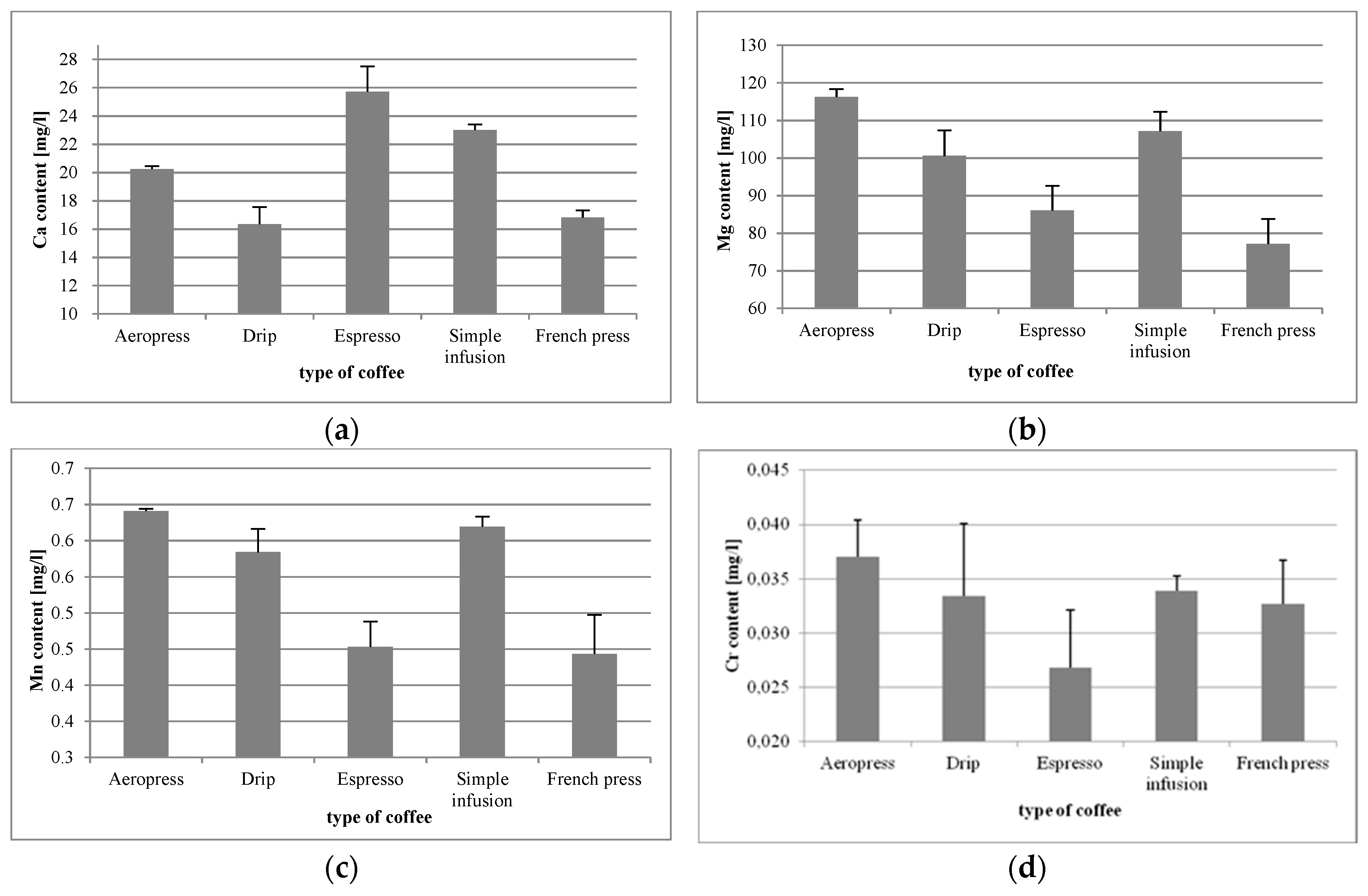


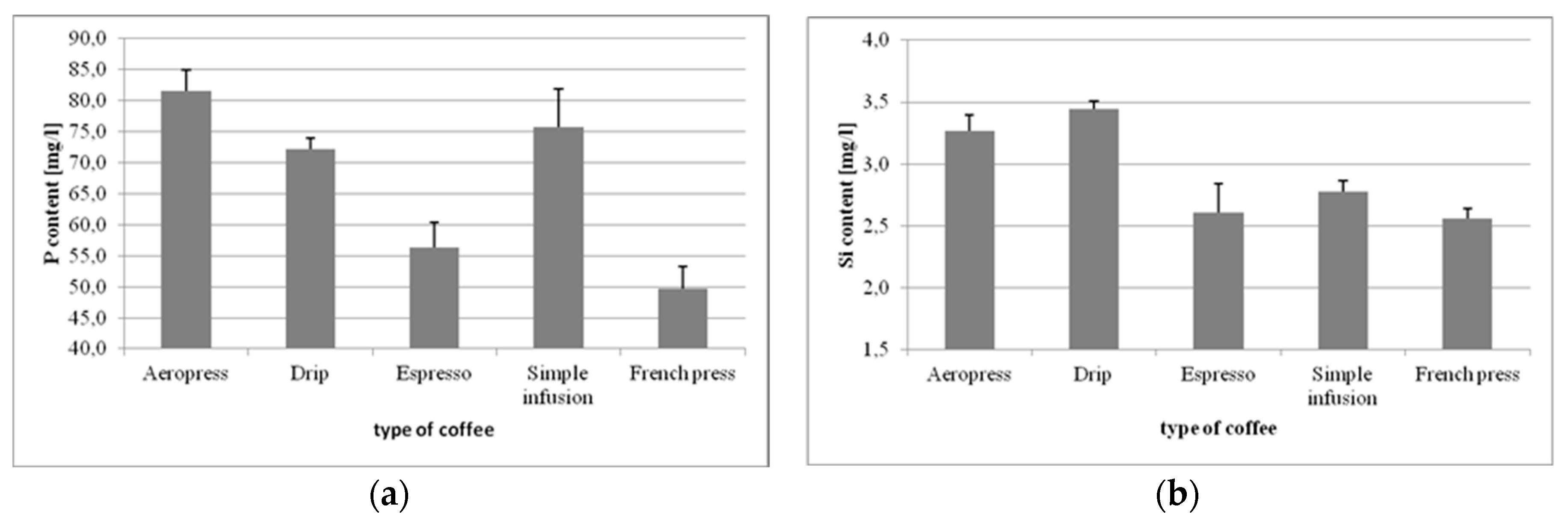
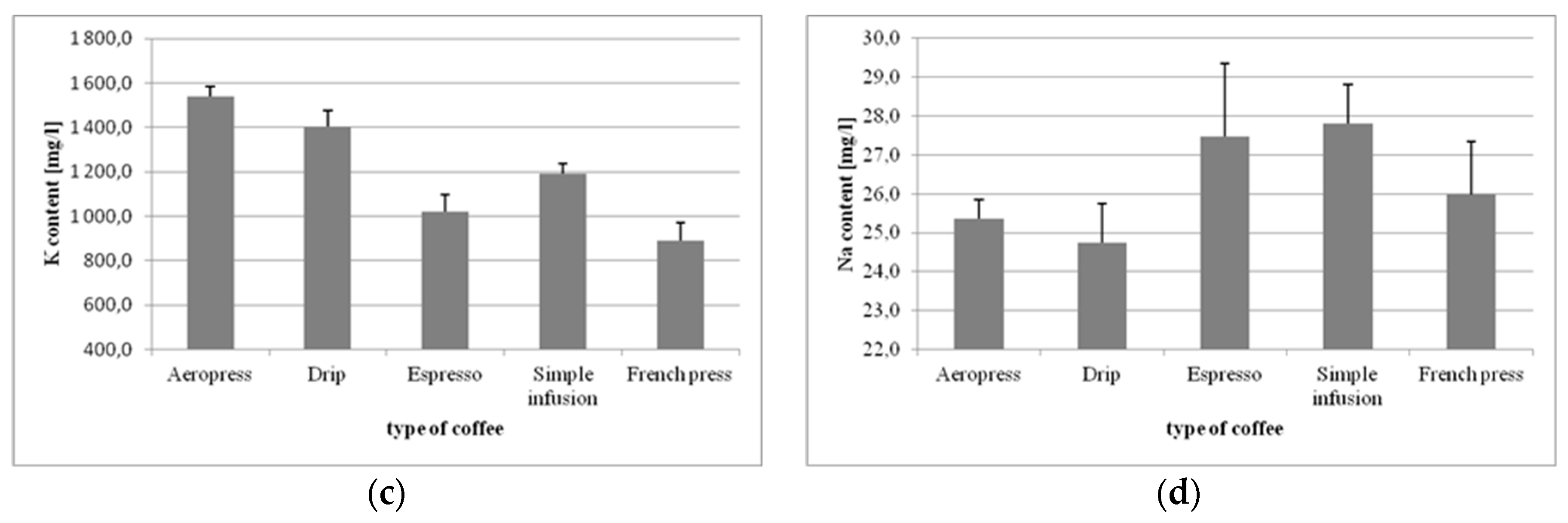
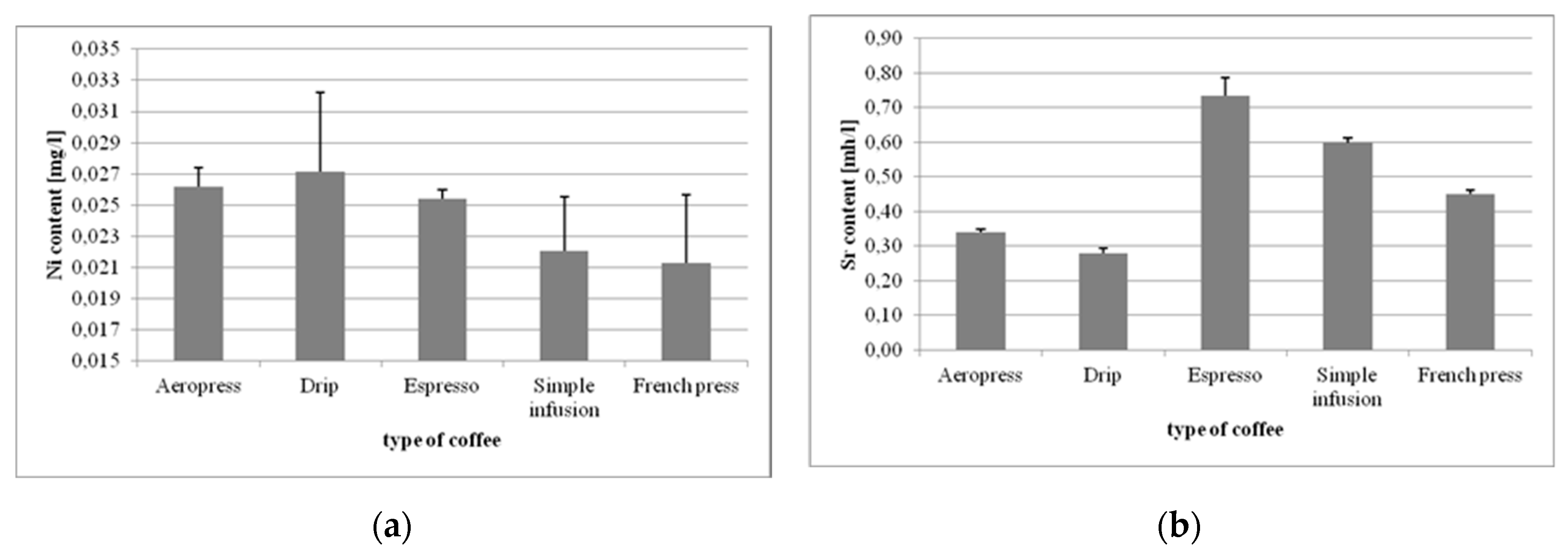
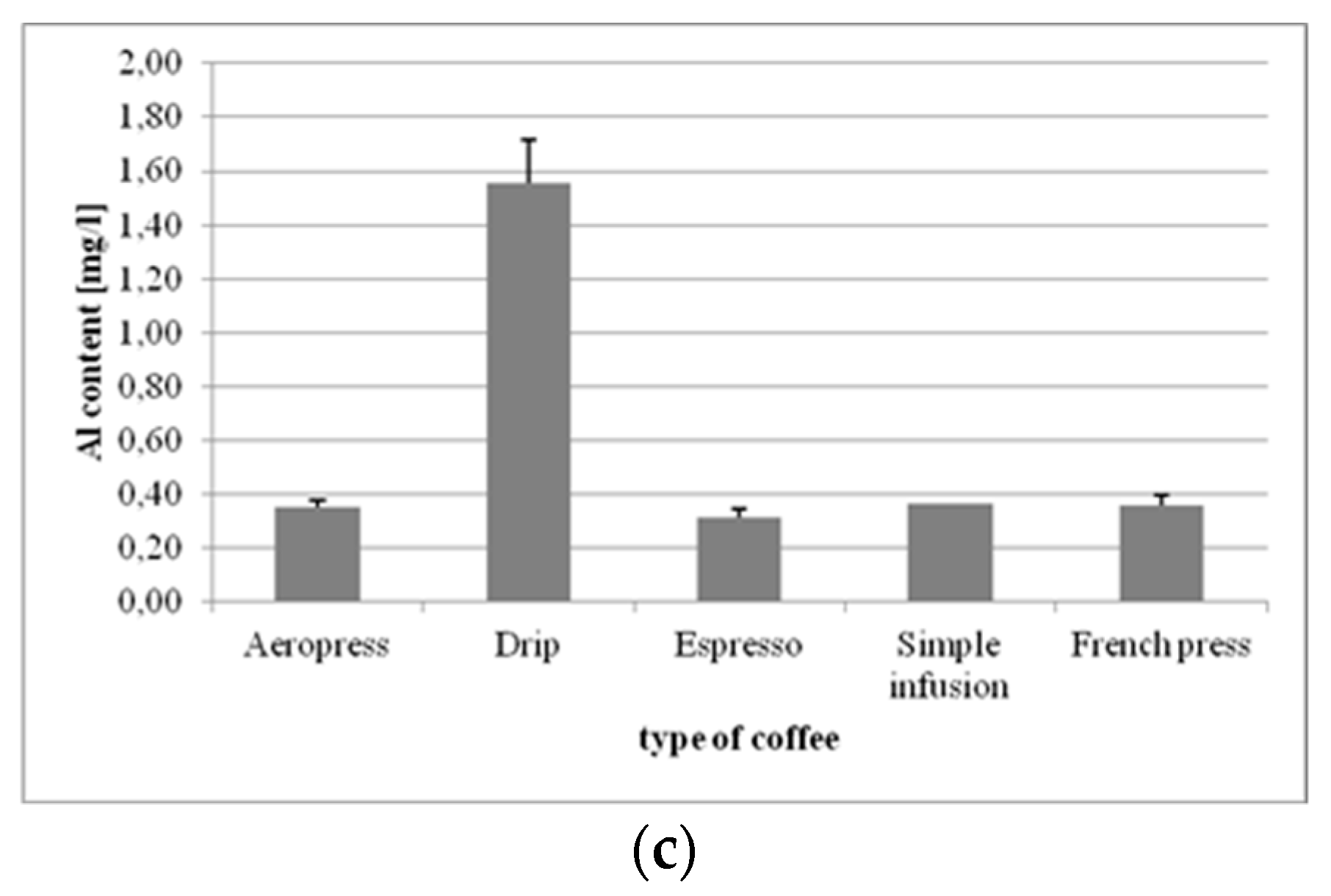
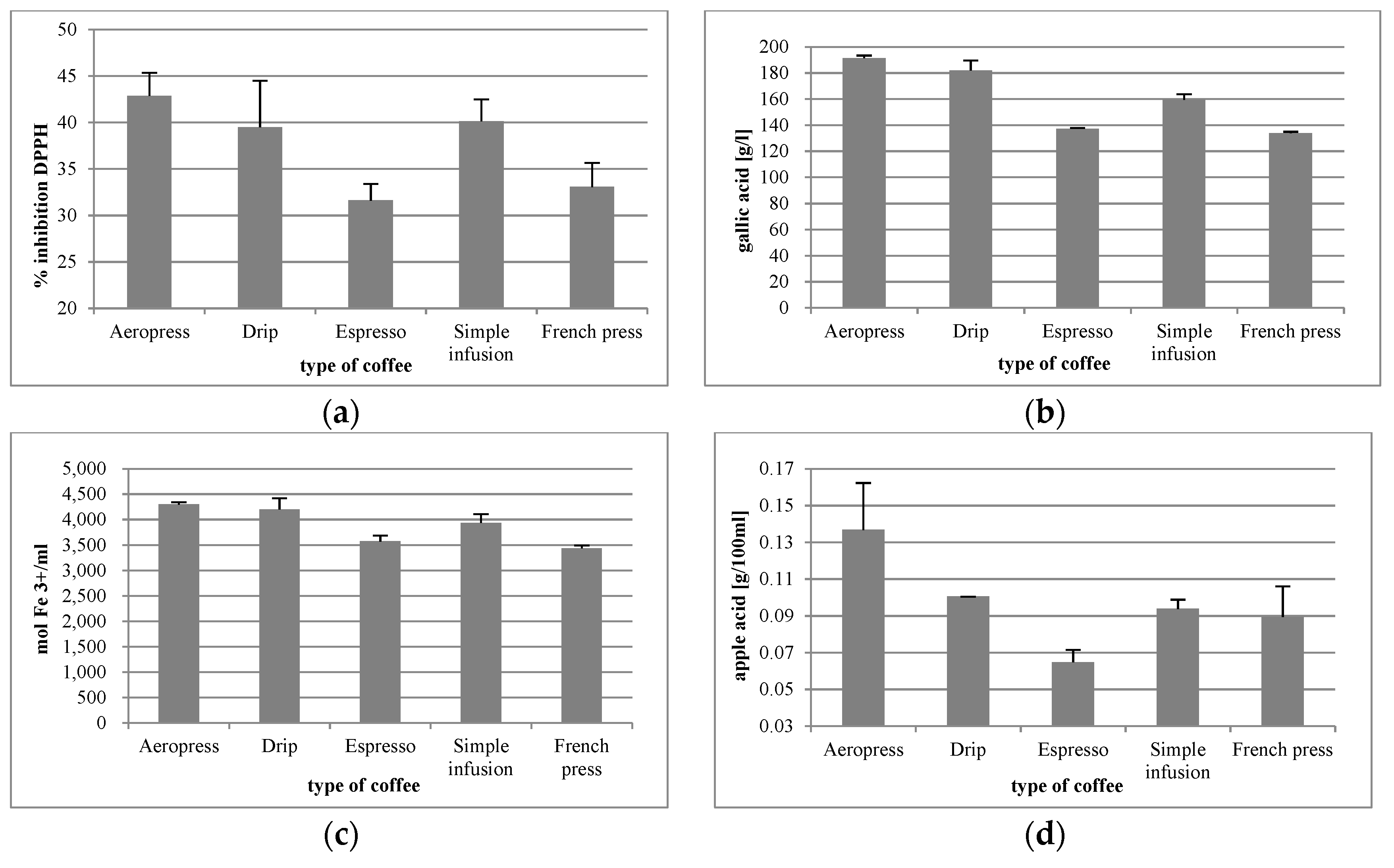
| Chemical Element | NIST-SRM 1486 Certified (mg/kg) | NIST-SRM 1486 Measured (mg/kg) | Recovery (%) |
|---|---|---|---|
| P 178.284 | 123,000.00 | 131,500.00 | 107% |
| K 766.490 | 412.00 | 417.00 | 101% |
| Ca 315.887 | 265,800.00 | 247,021.00 | 93% |
| Fe 239.562 | 99.00 | 102.15 | 103% |
| Zn 213.856 | 147.00 | 143.60 | 98% |
| Sr 421.552 | 264.00 | 258.17 | 98% |
| Na 589.592 | 5000 | 4826.33 | 97% |
| Mg 285.213 | 4600 | 4382.13 | 95% |
| Elements | Mineral Content (mg/kg) | |
|---|---|---|
| Mean | SD | |
| Ca | 1441.20 | 49.49 |
| Fe | 48.36 | 3.30 |
| Mg | 2133.91 | 43.42 |
| K | 18,634.66 | 538.67 |
| Na | 83.75 | 10.01 |
| Sr | 16.25 | 0.80 |
| Zn | 9.93 | 0.42 |
| P | 2154.23 | 41.80 |
| (a) Aeropress | ||
| Correlations (r) between Elements | ||
| Positive | Negative | |
| Ca and | Zn; Co | Fe; Cr; Ni |
| Mg and | K; Na; Co; Sr; Si | Fe; Cr; Ni; Al |
| Mn and | Zn; Al | P; Na; Sr; Si |
| P and | K; Na; Sr; Si | Zn; Al |
| K and | Na; Co; Sr; Si | Fe; Cr; Ni; Al |
| Zn and | Fe | |
| Fe and | Cr; Ni | Co |
| Na and | Co; Sr; Si | Cr; Al |
| Cr and | Ni; Al | Co; Sr; Si |
| Ni and | Co | |
| Co and | Sr | |
| Sr and | Si | Al |
| Al and | Si | |
| (b) Drip | ||
| Ca and | Mg; Mn; P; K; Na; Co; Al; Si | |
| Mg and | Mn; P; K; Na; Co; Sr; Al; Si | |
| Mn and | P; K; Na; Co; Al; Si | Zn; Ni |
| P and | K; Na; Co; Sr; Al; Si | |
| K and | Na; Co; Sr; Al; Si | |
| Zn and | Fe; Cr; Ni | |
| Fe and | Cr; Ni; Sr | |
| Na and | Co; Al; Si | |
| Cr and | Ni; Sr | |
| Co and | Sr; Al; Si | |
| Sr and | Al; Si | |
| Al and | Si | |
| (c) Espresso | ||
| Ca and | Mg; Mn; P; K; Na; Ni; Sr; Si | Zn; Cr; Co; Al |
| Mg and | Mn; P; K; Na; Ni; Sr; Si | Zn; Fe; Co; Al; Cu |
| Mn and | P; K; Na; Ni; S; Si | Zn; Cr; Co; Al |
| P and | K; Na; Ni; Sr Si | Zn; Fe Co; Al Cu |
| K and | Na; Ni; Sr; Si | Zn; Fe; Cr; Co; Al |
| Zn and | Cr; Al | Na; Ni; Sr; Si |
| Fe and | Co; Cu | Na; Sr |
| Na and | Ni; Sr; Si | Cr; Co; Al |
| Cr and | Al (r = 0.875) | Ni; Si |
| Ni and | Sr; Si | Al |
| Co and | Al; Cu | Sr; Si |
| Sr and | Si | Al |
| Al and | Si | |
| (d) Simple infusion | ||
| Ca and | Zn; Co | Fe; Cr; Ni |
| Mg and | K; Na; Co; Sr; Si | Fe; Cr; Ni; Al |
| Mn and | Zn; Al | P; Na; Sr; Si |
| P and | K; Na; Sr; Si | Zn; Al |
| K and | Na; Co; Sr; Si | Fe; Cr; Ni; Al |
| Zn and | Fe | |
| Fe and | Cr; Ni | Co |
| Na and | Co; Sr; Si | Cr; Al |
| Cr and | Ni; Al | Co; Sr; Si |
| Ni and | Co | |
| Co and | Sr | |
| Sr and | Si | Al |
| Al and | Si | |
| (e) French press | ||
| Ca and | Cr; N; Sr | |
| Mg and | P; K; Na; Ni; Si; Cu | |
| Mn and | P; K; Na | Zn; Fe; Cr; Sr |
| P and | K; Na; Ni; Si; Cu | Zn; Fe; Al |
| K and | Na; Ni; Si; Cu | Al |
| Zn and | Fe; Cr; Sr; Al | Na |
| Fe and | Cr; Al | |
| Na and | Ni; Si; Cu | |
| Cr and | Co; Sr; Al | |
| Ni and | Co; Si; Cu | |
| Co and | Sr | |
| Sr and | Al | |
| Si and | Cu | |
| Correlations (r) between Mineral Content and Acidity: | ||
|---|---|---|
| Positive | Negative | |
| (a) in Aeropress coffee infusion | ||
| acidity and | Mg; P; K; Na; Sr; S | Mn; Al |
| (b) in espresso coffee infusion | ||
| acidity and | Mg; P; K; Na | Fe; Co; Cu |
| (c) in simple infusion coffee | ||
| acidity and | Ca; Mg; P; K; Fe; Ni | Co |
| (d) in French press coffee infusion | ||
| acidity and | Mg; Mn; P; K; Na | Zn; Fe; Cr; Sr; Al |
© 2020 by the authors. Licensee MDPI, Basel, Switzerland. This article is an open access article distributed under the terms and conditions of the Creative Commons Attribution (CC BY) license (http://creativecommons.org/licenses/by/4.0/).
Share and Cite
Janda, K.; Jakubczyk, K.; Baranowska-Bosiacka, I.; Kapczuk, P.; Kochman, J.; Rębacz-Maron, E.; Gutowska, I. Mineral Composition and Antioxidant Potential of Coffee Beverages Depending on the Brewing Method. Foods 2020, 9, 121. https://doi.org/10.3390/foods9020121
Janda K, Jakubczyk K, Baranowska-Bosiacka I, Kapczuk P, Kochman J, Rębacz-Maron E, Gutowska I. Mineral Composition and Antioxidant Potential of Coffee Beverages Depending on the Brewing Method. Foods. 2020; 9(2):121. https://doi.org/10.3390/foods9020121
Chicago/Turabian StyleJanda, Katarzyna, Karolina Jakubczyk, Irena Baranowska-Bosiacka, Patrycja Kapczuk, Joanna Kochman, Ewa Rębacz-Maron, and Izabela Gutowska. 2020. "Mineral Composition and Antioxidant Potential of Coffee Beverages Depending on the Brewing Method" Foods 9, no. 2: 121. https://doi.org/10.3390/foods9020121
APA StyleJanda, K., Jakubczyk, K., Baranowska-Bosiacka, I., Kapczuk, P., Kochman, J., Rębacz-Maron, E., & Gutowska, I. (2020). Mineral Composition and Antioxidant Potential of Coffee Beverages Depending on the Brewing Method. Foods, 9(2), 121. https://doi.org/10.3390/foods9020121






